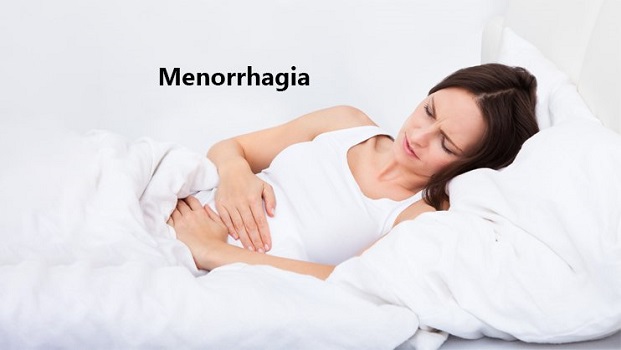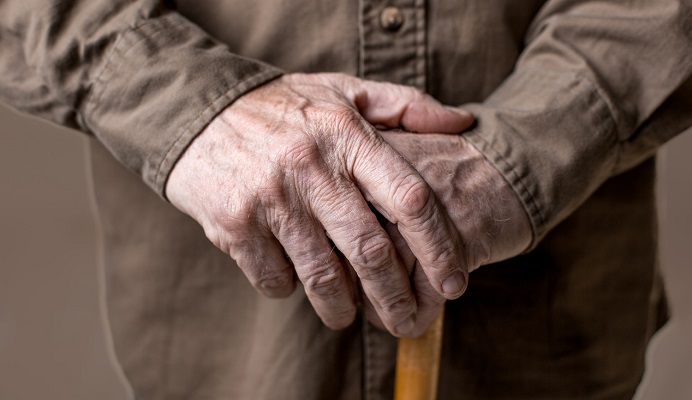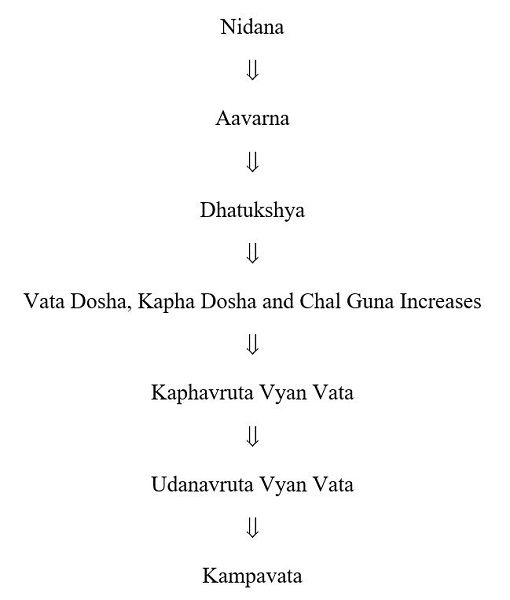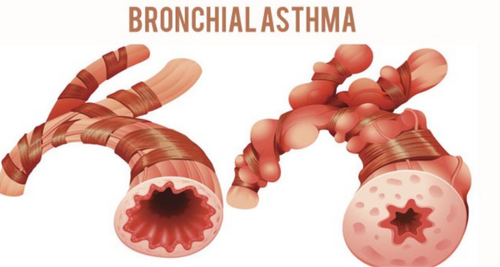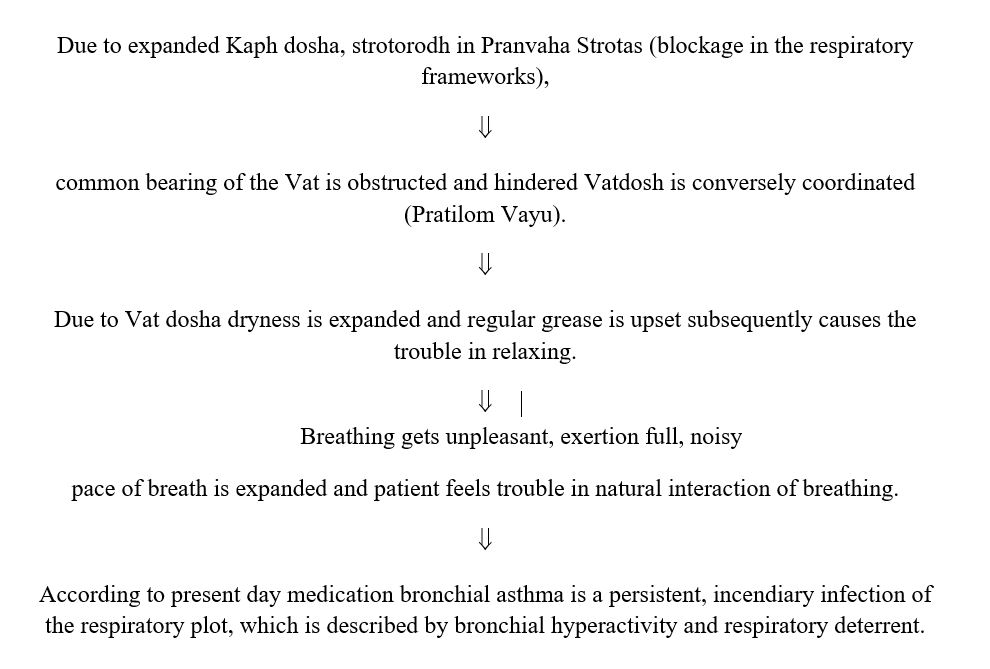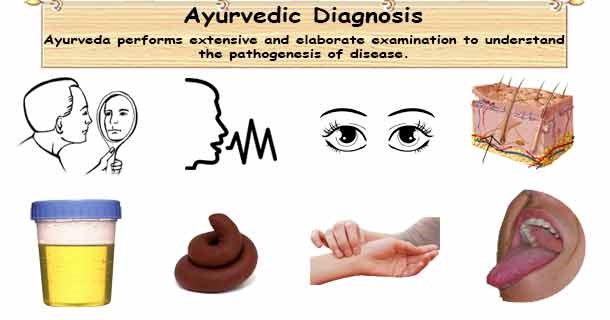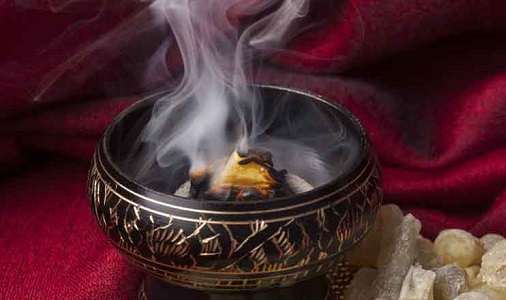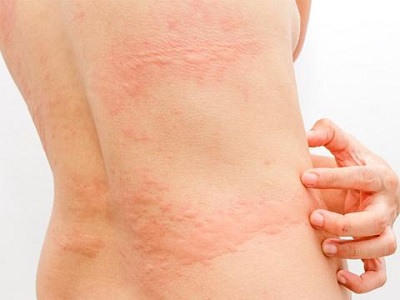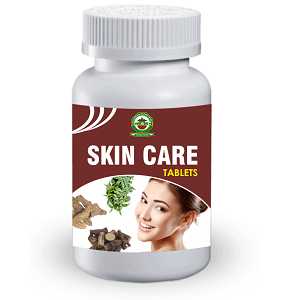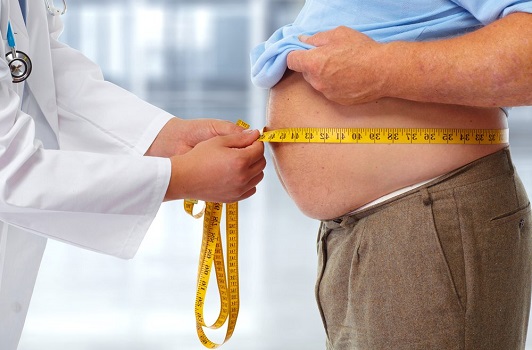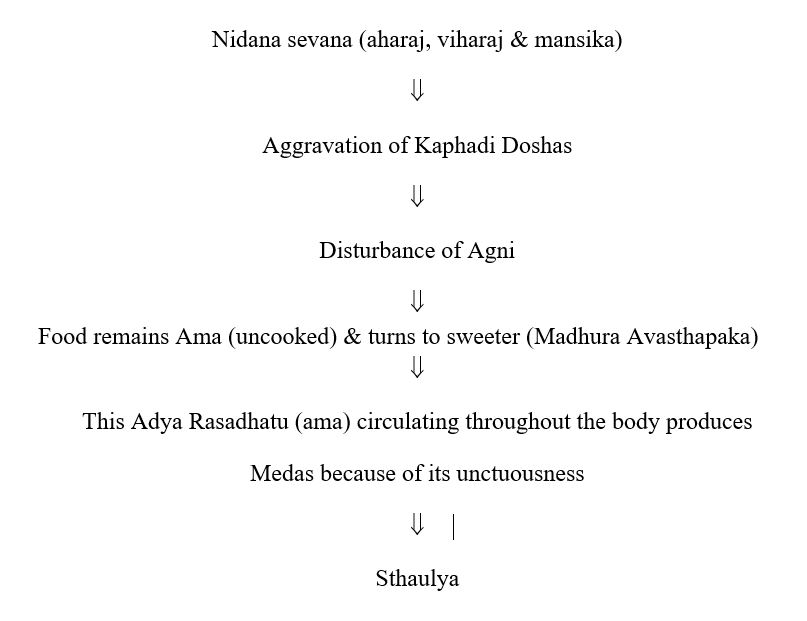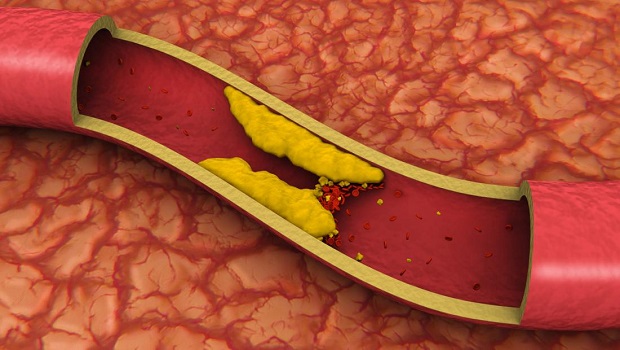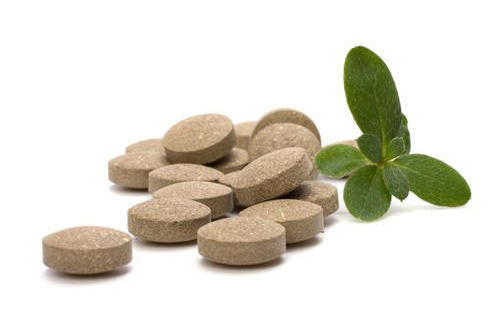Author Archives: Dr. Vaidya Karanvir Singh
AYURVEDIC PERSPECTIVE OF MENORRHAGIA: ASRIGDARA
- May 7, 2021
- Posted by Dr. Vaidya Karanvir Singh
- 0 Comment(s)
DEFINITION
Menorrhagia is defined as prolonged and excessive menstrual bleeding at regular menstrual cycle intervals. In Ayurvedic classics, it is known as Asrigdara, literally meaning ‘heavy flow of blood’, and is caused by vitiation in both the pitta dosha and rakhta dhatu (blood tissue).
SYNONYMS:-
- Asrigdar
- Menorrhagia
- Yonivyapad
- Artavadushti
- Pittaj Rajodushti
- Raktapradar
- Lohitkshara Yonivyaapad
DOSHA-DUSHYA
Dosha – Apan Vayu, Vyan Vayu and Pitta Dosha
Dushya – Ras Dhatu and Rakta Dhatu
ETIOLOGICAL FACTORS
1. ACCORDING TO AYURVEDA
Etiological factors for heavy menstrual bleeding according to Ayurveda Acharya Charak have described the following causes of Asrugdar in Charak Chikitsa Sthan 30
- Intake of excessive sour, salty, heavy, katu, vidahi Anna which produces a burning sensation.
- The woman who consumes meat of domestic, aquatic, fatty animals.
- Payasa(rice cooked with milk)
- Curd, Curd water (Mastu) and suktall (vinegar)
- Adhyashan- Taking food before digestion of food already taken.
- Virudhashan- Incompatible diet
- Miscarriage
- Excessive coitus
- Riding, weight lifting
- Trauma
- Day Sleeping
2. ACCORDING TO MODERN SCIENCE
- Hormonal disturbances – Thyroid, obesity, and pcods lead to hormone imbalance and may result in If there is a change in the normal fluctuations of progesterone and estrogen, the endometrium, can build up too much. This is then shed during menstrual bleeding.
- Intrauterine device – Menorrhagia is a well-known complication of using a non-hormonal IUD.
- Pregnancy complications – An unusual location of the placenta, such as a low-lying placenta or placenta previa.
- Cancer – Uterine cancer and cervical cancer can cause DUB.
- Bleeding Disorders – A condition in which an important blood-clotting factor is deficient or impaired can cause abnormal menstrual bleeding.
- Adenomyosis – Adenomyosis often causing heavy bleeding and painful periods.
- Medications – Anti-inflammatory medications, hormonal medications (estrogen and progestins), and anticoagulants like warfarin or Lovenox, can cause heavy or prolonged menstrual bleeding.
- Uterine Fibroids
- Dysfunction of the ovaries.
- Other medical conditions – A number of other medical conditions, including liver or kidney disease, may be associated with menorrhagia.
SIGN AND SYMPTOMS
- Prolonged bleeding, longer than seven days
- Heavy bleeding, needing to change one or more sanitary pads or tampons every hour.
- Needing to use double sanitary protection to control your menstrual blood flow.
- Passing blood clots larger than a quarter with menstrual flow
- Restricting daily activities due to heavy menstrual bleeding.
- Needing to wake up to change sanitary protection during the night.
- Symptoms of anemia
- Tiredness
- Fatigue
- Shortness of breath (dyspnea)
DIAGNOSIS
- Blood tests – A sample of blood for iron deficiency (anemia) and other conditions, such as thyroid disorders or blood clotting abnormalities
- Ultrasound (USG)
- Endometrial biopsy
- Sonohysterography
- Hysteroscopy
AYURVEDIC MANAGEMENT OF MENORRHAGIA
According to Sushruta charya there are four measures for preventing excessive blood loss are as follows
- Sandhan – In sandhan karma wound healing is mainly done by Kashay rasatmak dravyas such as Lodhra (Symplocosracemosa), Udumber (Ficus racemosa), Nyagrodh (Ficus bengalensis).
- Skandana – Skandan Karma means coagulation which is done by dravyas having sheet virya or sheet guna pradhan dravyas.
- Pachana – Pachan karma carried out with Bhasma.
- Dahan Karma – By cauterization of blood vessels also proves efficient in controlling blood loss.
ABHYANTARA CHIKITSA
- Intake of Bala root powder with 40ml milk twice a day.
- Ashoka (saraca indica) twak ksheerpan 40 ml twice a day
- Kesar (saffron) with 1 tsp of honey and lick the spoon clean
- 1 gram lodhra choona, 1gram Nagkeshar choorna and 250 mg pravala bhasma should be intake with Rice water in twice a day.
- Lodhra choorna 1 gm + Jahar mohra churna pishti 250 mg
- Pushyanug Churna with tandulodaka (rice water)
- Eat kishmish (raisins) to satisfy your sweet tooth, while also pacifying the aggravated Pitta dosha.
- One glass milk with 1tsp ghee and ¼ tsp turmeric powder twice a day
- Phala ghrita with milk 10 ml once daily.
- Chandraprabha vati twice a day
- Ashwagandha churna-5mg twice a day
- Gairika bhasma + Pravalabhasma-10 gm BD
- Nagakesara (Mesua Ferrea) and Ushira (Vetiveria zizanioides) 3-5 grams combined with butter and mishri (rock sugar).
Chandigarh Ayurved Centre is the best center that treats menorrhagia of its root cause. CAC medicines for menorrhagia are:-
- Immuno Up Powder
- Feminine Care Tablet
- Makar Rasayan Tablet
- Stop Bleeding Tablet
APATHYA (DIET RESTRICTIONS)
- Avoid hot and spicy foods
- Avoid coffee and alcohol
- Low-fat diets will be good
- High fiber diet is recommended
- Cakes, cookies & pastries should be avoided
Parkinson’s Disease (Kampvata)
- May 7, 2021
- Posted by Dr. Vaidya Karanvir Singh
- 0 Comment(s)
Parkinson’s disease is a sensory system infection that influences our capacity to control development. The infection ordinarily begins gradually and deteriorates over the long haul. On the off chance that you have Parkinson’s infection, we may shake, have muscle firmness, and experience difficulty strolling and keeping up our equilibrium and coordination.
In Ayurveda Parkinson’s disorder is similar to Kampavata, which is ordered among nanatmaja issues of Vata
Samprapti of Kampvata
Causative Factors of Kampvata
Aharaja (Dietetic Components)
- Rukshanna (Ununctuous diet),
- Laghvana (Light eating routine),
- Kashayanna (Astringent taste),
- Katvanna (Acrid taste), Tiktanna (Bitter taste),
- Abhojana(starvation),
- Alpasana, Pramitasana (less amount food).
Viharaja (Regimen Factors)
- Atilanghana (Leaping over ditch),
- Atipradhavana (Excessive running),
- Atiprajagara (Excessive arousing),
- Ativyavaya(Excessive sex),
- Ativyayama (Violent exercise)
- Manasika (Psychological components)
- Bhaya (Fear), Chinta (Thinking), Shoka (Grief),
- Utkantha (Anxiety)
Miscellaneous Variables
- Abhighata (Trauma), Ama (Undigested article),
- Asrika Kshaya (Loss of blood),
- Dhatukshaya(Loss of body components)
- Atiyoga of Stambhana and complexity of Vamana Karma,
- Indication or confusion of Vataja Ardita (B.P.Vatavyadhi).
Symptoms in Parkinsonism
- Balance issues – these can make somebody with the condition bound to have a fall and harm themselves.
- Loss of feeling of smell (anosmia) – now and again happens quite a while before different manifestations create
- Nerve torment – can create disagreeable uproars, like consuming, frigidity or deadness
- Issues with peeing –, for example, getting up every now and again during the night to pee or unexpectedly peeing (urinary incontinence)
- Constipation
- A powerlessness to acquire or support an erection (erectile brokenness) in men
- Trouble getting explicitly stimulated and accomplishing a climax (sexual brokenness) in ladies
- Wooziness, obscured vision or blacking out while moving from a sitting or lying position to a standing one – brought about by an abrupt drop in circulatory strain
- Excessive sweating (hyperhidrosis)
- Gulping troubles (dysphagia) – this can prompt unhealthiness and lack of hydration
- Exorbitant creation of spit (slobbering)
- Issues resting (sleep deprivation) – this can bring about unnecessary drowsiness during the day
- Melancholy and uneasiness
- Gentle intellectual disability – slight memory issues and issues with exercises that require arranging and association.
Treatment of Kampvata
Ayurvedic medication offers some treatment alternatives if there should arise an occurrence of Parkinson’s disease. Ayurvedic treatment for this condition primarily dependent on the treatment of unequal VATA. Inner and External Oleation (Snehanam) and fomentation (Swednam) structure the premise of the sacred treatment. Oleation should be possible by interior utilization of sedated oils and Ghee. Outer Oleation should be possible by Massage (Ayurvedic Abhyangam). The significant strategy that is referenced in the books of Ayurveda for the treatment of KAMPHA VATA is Basti or Vasti treatment. Vasti (Anal bowel purge) is the best refinement strategy to adjust the upset Vata. Ayurveda likewise offers a wide scope of natural enhancements to help patients with Parkinson’s. As of late numerous examinations directed all throughout the planet have demonstrated the presence of L-dopa (Which is antecedent for Dopamine) is available in a portion of the Ayurvedic spices.
Bronchial Asthma (Tamaka Shwasa)
- May 4, 2021
- Posted by Dr. Vaidya Karanvir Singh
- 0 Comment(s)
Bronchial asthma is a disorder that causes the aviation routeway of the lungs to expand and limit. Because of this growth, the airway creates an abundance of bodily fluid making it difficult to inhale, which brings about hacking, short breath, and wheezing. The infection is ongoing and meddles with day-by-day working. The sickness is treatable and inhalers help defeat asthma assaults. Bronchial Asthma can influence any age or sexual orientation and relies on ecological and inherited factors on the loose.
In Ayurveda, Bronchial Asthma is also called Tamak Shwasa. Tamaka Shwasa is a wide term that incorporates a lot more sicknesses where dyspnoea is the prevalent symptom. Yet at the same time, we can correspond Bronchial Asthma to Tamaka Shwasa.
Causative Factors of Asthma
- Viral Infection like cold and influenza, or pneumonia,
- Air Pollution, smoke, exhaust from vehicles, etc.
- Stress and anxiety.
- Physical movement or exercise prompted asthma.
- Medications like anti-inflammatory medicine, Ibuprofen, beta-blockers, etc.
- Acid reflux or gastroesophageal reflux illness (GERD).
- Perfumes and fragrances.
- Weather, particularly outrageous changes in temperature.
- Food added substances.
Samprapti (Pathogenesis) of Tamak Shwasa
Sign & Symptoms of Asthma
Asthma signs change starting with one individual then onto the next. You may have uncommon asthma attacks, have side effects exactly at explicit.
Asthma Signs and Indications Include:
- Windedness
- Chest coziness or torture
- Wheezing while at the same time breathing out, which is a normal sign of asthma in young people
- Inconvenience snoozing achieved by shortness of breath, hacking or wheezing
- Hacking or wheezing attacks that are crumbled by a respiratory disease, similar to a cold or occasional flu
Signs that Your Asthma is in All Likelihood Crumbling Include:
- Asthma signs and indications that are more consistent and bothersome
- Expanding inconvenience breathing, as assessed with a contraption used to check how well your lungs are working (top stream meter)
- The need to use a quick assistance inhaler even more consistently
For Certain People Groups, Asthma Signs and Side Effects Emit in Explicit Conditions:
- Exercise-incited asthma, which may be all the more dreadful when the air is cold and dry
- Word related asthma, set off by workplace aggravations like compound exhaust, gases or buildup
- Sensitivity provoked asthma, set off by means of airborne substances, similar to clean, structure spores, cockroach waste, or particles of skin and dried spit shed by pets (pet dander)
Complications of Bronchial Asthma
- Intense serious asthma
- Repetitive bronchitis and pneumonia (from irresistible)
- Atelectasis (breakdown) of lung or bronchiectasis (from mucous fittings)
- Emphysema
- Pneumothorax (unconstrained) Ongoing Cor Pulmonale and Respiratory Disappointment (in late-stage)
Management of Tamak Shwasa
Nidana Parivarjana
The first line of treatment is to stay away from the causative elements. On the off chance that the encouraging or inclining factors are not stayed away from, the Doshas associated with the pathogenesis will additionally be disturbed and the visualization will be more awful. In the treatment of Tamak Shwasa (Bronchial Asthma) aversion of causative factors or setting off factors play a very significant job.
Samshaman and Samshodhana Chikitsa
The line of treatment dependent on these treatments depicted by Acharya Charaka can be partitioned as:
- Samanya Chikitsa Krama (General standards of treatment)
- Vishisht Chikitsa Krama (Specific treatment)
1) Samanya Chikitsa Krama (General standards of treatment)
Charak referenced the treatment of tamak Shvasa according to Doshic status.
- Vata-kaphanashak chikitsa
- Vata Karak and kaphanashak chikitsa
- Kaphakarak and vatanashak chikitsa
At the point when Vata and Kapha are similarly vitiated then Vata Kaphanashaka Chikitsa is helpful. At the point when Kapha causing obstacle of Vayu then Kaphnashak and Vatakarak
Chikitsa is helpful out of all these “Anilapaham” Chikitsa is viewed as an unrivaled one. Brihan Chikitsa has been shown in Shwasa Roga.
2) Vishisht Chikitsa Krama (Specific treatment)
As indicated by the transcendence of Dosha the patient of Shwasa can be isolated into two gatherings:
- Vata prevalent
- Kapha prevalent
As indicated by the body fabricated the patient of Shwasa can be isolated into two gatherings:
- Balvana (with great body assembled)
- Durbala (with helpless body assembled)
Samshodhan Chikitsa
- Snehana
- Swedana
- Vamana
- Virechana
- Dhumpana
- Nasya
- Dahkarma (Cauterization)
ASHTVIDHA PARIKSHAN (METHODS OF DIAGNOSIS IN AYURVEDA)
- May 4, 2021
- Posted by Dr. Vaidya Karanvir Singh
- 0 Comment(s)
INTRODUCTION
Ayurveda is based on the sound principles of diagnosis. It does not require clinical or costly investigations. Ashtvidha pariksha is mentioned by Acharya Yogaratnakara.
Ashtashana pareeksha is one among the different methods of rogi pareeksha there are 8 factors that are taken into consideration during the examination and tests carried out with the patients. Also, Nadi Pariksha is one of the most significant examination parts for diagnosis of the disease of patients.
ASHTVIDHA PARIKSHA
- Nadi – The pulse
- Mootram – The urine
- Malam – The facal matter
- Jihwa – The tongue
- Shabda – The voice of patients
- Sparsha – Touch
- Druk – The eyes and vision
- Akruti – General body build
1. NADI PARIKSHA
Nadi apriksha is one of the most important methods of diagnosis in Ayurveda. Many physicians can make the diagnosis only by examining the pulse. The examination of strength, rhythm, speed, quality of the Nadi shows each change occurring in the body, just similar to the strings of Veena which produce music.
SYNONYMS:-
- Dhamani
- Tantuki
- Snayu
- Jeevanajnaana
TYPES OF NADI:-
- Vata Nadi – it is fast, irregular, moves like a snake. In modern science it can be compared with thread and irregular pulse. It can be felt in the Agra bhaga ie. By index finger
- Pita Nadi – in this pulse is throbbing, rich, forceful and elevated in middle. It can be compared to the jumping frog. It can be felt by middle finger
- Kapha Nadi – kapha pulse is slow, steady and somewhat heavy. Kapha nadi can be compared to the movement of a stork. It can be felt by ring finger (Anamika Anguli).
PROCEDURE:-
- The best time for naadi pareeksha is in the morning.
- Both vaidya and rogi should have calm and cool mind.
- They must sit in a comfortable – place facing each other.
- The naadi of the right hand will be clear in males, while in female that of left hand.
- The patient’s wrist should be partially flexed and extended fingers
- Physician should hold the wrist of the patient by the examining hand and should place his index, middle and ring fingers one angula below the Angushtamoola & then must examine the naadi.
- The index finger should be nearer to the root of the thumb.
NADI IN VARIOUS DISEASES: –
- Jwara – Pulse is hot and rapid in fever.
- Kaama and krodha – Pulse rate increases during lust and anger.
- Chinta and bhaya – Pulse rate decreases during worry and fear.
- Mandagni and dhatukshaya – Slow and feeble type.
- Hunger – During hunger nadi becomes unsteady and after meal it becomes stable.
2. MUTRA PARIKSHA
The urine examination is done by naked eye to check for its color, frequency, consistency and sediments. Urine is an important waste product of the body and its examination yields valuable information regarding health and ill health.
PROPERTIES OF URINE
- Ishat Peetavarnam
- Apicchilam (Non-Greasy)
- Anavilam (Clear)
- Ushna, Thikshna and Kshara
METHOD OF COLLECTION
- The mootra should be collected during the last prahara of night (early morning).
- It must be collected in a clean glass vessel and examined after sunrise.
- The middle stream is collected and initially expelled urine is expelled.
COLOUR IN VARIOUS DISEASES
- Agnimandya – Matulungarasa
- Ajeerna – Tandulodaka
- Vatapittaprakopa – Dhumrajalabha
- Vatakapha Prakopa – Phenila and Sweta
- Kaphapittaprakopa – Rakthavarna and Kalusha
TAILA BINDU PARIKSHA
Tailabindu pariksha is a diagnostic tool of urine examination developed by the Acharya Yogaratnakar. Taila bindu pareeksha on mutra of different individual is used to determine the sadyaasadyata of a disease.
One drop of pure sesame oil is put over a cup of freshly collected urine, then note its spread:
- Spread towards varuni direction-good prognosis
- Southwards, agneya, vayavya, nairitya-bad prognosis
- Shape indicating good prognosis Lotus, jasmine, swan, pond, elephant, mountain, palace, tree
- Shape indicating bad prognosis – Dot, arrow, tortoise, ear lobe, man without head, part of an organ, bull, lion, tiger, pig
- Vatika – Boat like & lengthens like serpent
- Paitika – Ring like & produces bubbles
- Kaphaja – Sieve like & stays like a pearl
3. MALA PARIKSHA
- If Mala Vitiated by Vata -Dry, Hard with Blackish Discoloration
- If Mala Vitiated by Pitta -Yellow & Green Colored
- If Mala Vitiated by Kapha – White Colored Stools
4. JIHWA PARIKSHA
- Vata Prakopa – Cold, Rough and Cracked Tongue
- Pittaprakopa – Yellow or Red Color Tongue
- Kaphaprakopa – White & Slimy
- Dwandaprakopa – Combined Features
- Sannipata Pakopa – Black in Color with Thorn Like Structures
Some other features such as coating of tongue, loss of sensation, any change in size, ulcers formation, discoloration, etc. are to be tested.
5. SHABDA PARIKSHA
- Vataparakopa – Guru, Sphuta and Abnormal Shabda
- Pittaprakopa – Aspashta Shabda
- Kapha Prakopa – Guru, Durbala, Aspashta and Nasarodha Anunasika Shabda
- Vaatapitta – Pralaapa (Delerium)
6. SPARSHA PARIKSHA
- Vataja Lakshana– Sheeta Sparsha
- Pittaja Lakshana– Ushna Sparsha
- Kaphaja Lakshana– Ardra Sparsha
7. DRUK PARIKSHA
- Vataja – Smoky (Dhoomra) Aruna Varna, Ruksha, Chanchala Sunken Eyes (Antahpravishta).
- Pittaja – Haridra and Rakta Varna, Thikshna, Lustrous (Prabha Yukta) And Dahayukta
- Kaphaja – Sveta, Dhavala, Snigdha
8. AKRITI PARIKSHA
- It is the judgment of one’s disease status by the examination of one’s body features.
- Pramana & samhanana pariksha are essential in this.
AYURVEDA FOR PARALYSIS
- May 4, 2021
- Posted by Dr. Vaidya Karanvir Singh
- 0 Comment(s)
INTRODUCTION
In Ayurveda Paralysis has been discussed under Vata vyadhi disorder. In Ayurveda, it is termed as Pakshaghata which means impairment of Karmendriyas/paralysis of one half of the body where “paksha” denotes either half of the body and “Aghata” denotes the impairment of body movements and mental stability.
DEFINITION
Paralysis is a condition where partial or complete loss of function especially when involving the motion or sensation in a part of the body or loss of the ability to move
Partial loss of body function is termed hemiplegia and complete loss of body function is paraplegia.
TYPES OF PARALYSIS
There are many types of paralysis:
- Facial Paralysis – loss of strength and mobility of facial muscles.
- Monoplegia – loss of strength of one limb.
- Hemiplegia – affecting one side of the body such as the leg and arm of the same side of the body.
- Paraplegia – Paralysis of both legs and sometimes parts of the trunk.
- Quadriplegia – affects both arms and both legs
CAUSES OF PARALYSIS
There are many reasons for this condition. The most common reasons are:
- Uncontrolled High Blood Pressure.
- Head Injury Due to Trauma or Accident
- Severe Brain Infection
- Brain Tumors
- Cerebral Haemorrhage
- Shock
CLINICAL FEATURES
- In severe cases of paralysis bowel and Bladder may be affected
- Impaired movement of hands and legs.
- Instability mental function.
- Speech may be affected (slurred speech)
- Temporary loss of vision in one or both eyes or blurry vision.
- Difficulty in swallowing
- Headache
- Unable to understand
- Rapid unintentional eye movement.
- Whole-body fatigue, light-headedness, or vertigo
- Walking difficulty and numbness in limbs
- In case of facial paralysis dropping of eyelid and mouth deviation are seen
DIAGNOSTIC CRITERIA FOR PARALYSIS
Identifying and diagnosing external paralysis is easy as there’s a clear loss of movement and muscle function in a body part. For internal body parts where paralysis is more difficult to identify, your physician may use some imaging studies such as-
- X-Rays
- MRI (Magnetic Resonance Imaging)
- CT-SCAN
- Myelography
- Electromyography (EMG)
- Spinal Tap
MANAGEMENT IN AYURVEDA
AYURVEDIC MEDICINE FOR PARALYSIS
Traditional medicines in the form of crude herbal extracts of a single plant or combination of plants, with or without additional minerals have been used in alleviating and curing disorders related to problems of the nervous system, some of which includes:
Herbs like:
- Ashwagandha (Withania Somnifera)
- Brahmi (Bacopa Monnieri)
- Eranda (Ricinus Communis
- Rasona (Allium Sativum)
- Rasna (Pluchea Lanceolata)
Medicines like:
- Dashmoola Arista
- Sarasawathaarista
- Bhihat vata Chintamani
- Ekangavira rasa
- Mahavatavidwamsana
- Balarista
- Sacharadi kasahya
- Gandarwahastadi qwatha
PANCHAKARMA FOR PARALYSIS
Paralysis can be treated by Panchakarma which is one of the significant treatment modalities of Ayurveda. Panchakarma means five procedures, which are as follows:
- Vamana (therapeutic emesis)
- Virechana (purgation)
- Asthapanvasti (enema using medicated decoction)
- Anuvasanvasti (enema using medicated oil)
- Shirovirechan /Nasya (nasal administration of medicines).
Along with these five major procedures there are various other allied therapies such as oleation (snehana), perspire (swedana) are also overall comes under panchakarma.
- Snehana (Oleation)treatment like massage, Kayaseka, Shirodhara, Shirobasti, Pichu etc with medicated oils followed by different modalities of Medicated fomentation for 7 – 21 days.
- Abhayanga (Massage)with symptom specific medicated oils followed by medicated fomentation helps to increase circulation also strengthens the muscles and nerves.
- Virechana (Purgation) – To increase the Metabolism, to relieve constipations, strengthens the gut, also helps to improve the functioning of the nerves in the affected area.
- Basti(Enema) in the form of Matra Basti, Anuvasana Basti, Nirooha Basti for the period of 8 – 32 days.
- Medicated enema helps in nourishing, strengthening, and also stabilizing the overall functions of the body functioning and this treatment takes a major role in healing the paralytic patient.
- Nasya karma for 7 – 9 days -Therapy helps to strengthen the muscles, nerves and circulation above the shoulder.
- Panchakarma has no side effects and it is more useful in treating neurological diseases as well as paralysis.
“The Procedure such as Patra pinda Sweda, Shashtika shali pinda Sweda, Anuwasana Basti, Shirodhara, Shiro Basti, Sarvanga Abhyanga helps in nerve strengthening and increases blood circulation in affected areas, that helps to fasten and progress the movements”.
PATHYA-APATHYA FOR PARALYSIS
- Avoid food items that are spicy, astringent and oily/fatty food.
- Include foods that are sweet, sour, and salty.
- Avoid incompatible diet (Viruddhahara), bengal gram, peas, potato etc.
- Use onion, garlic, ginger, black gram, horse gram, radish, ash gourd, green gram etc in regular diet.
- Pomegranate, grape or papaya fruits are very useful in paralysis
- Carrot, beetroot, okra, and asparagus should be part of your daily diet.
- Intake high fiber food items as advised by the physician.
- Control the treatable risk factors like diabetes mellitus, hypertension, heart diseases.
- Practice regular exercises or physiotherapy.
- Avoid excessive fasting
- Avoid excess exercises, suppressing natural urges.
- Avoid alcohol consumption and smoking.
- Be active and optimum use of the affected parts.
Role of Dhoopan in Slowing Down COVID Spread
- May 4, 2021
- Posted by Dr. Vaidya Karanvir Singh
- 0 Comment(s)
- Dhoopan is an Ayurvedic procedure in which fumes or smoke produced from defined Ayurvedic drug formulations are inhaled/exposed by patients for medicinal/therapeutic relief or externally as a cleanser to the environment.
- There is a major risk of spread of airborne infections with hospital-acquired infections and to mitigate Dhoopan is a safe practice and very effective to control such infections.
- Dhoopan is a classical ayurvedic method of sterilization for Vranitagar (wound healing), Sutikagar, Kumaragar, etc. with preventive as well as curative/restorative efficacy. Fumes can be facilitated to expose or inhale in various diseases such as cough, fever, coryza, piles, epilepsy, insanity, Asthma, bronchitis, and wounds.
- The constituents of Dhoopare Ayurvedic herbs, animal products (like skin, hair, bones, horn, etc.), and various minerals, described in Ayurveda are efficient anti-microbial, anti-fungal, and antiviral action by nature.
- Since ancient times, sages used to clean the environment by havanaadi (home)rituals. However, because of the lacking scientific validation, these Dhoopan practices are not famous, which bring attention to research opportunities and understand its safety, potency, and efficacy to control airborne infections.
- Dhoop kalpas have advantages in dealing with airborne infection because of antioxidant and anti-microbial properties with safe, economical, and eco-friendly potential. Thus, it can be publicized in the prevention and control of COVID 19 like a pandemic situation as a supplementary method.
- Airborne infections are the commonest ones, develop respiratory disorders. COVID 19 is one of the viral respiratory problems, created pandemic with a high death rate. Covid spreads from droplets, aerosol, and fomite by the affected patient’s cough, nasal secretions, sneeze, sputum, or nasal discharge, and the environment gets easily contaminated.
- Airborne infections can rapidly spread in masses through breathing and inhalation of microbes in an infectious environment. Therefore, this is required to sterile the area by disinfectant herbs or fumigation.
- There are many types of microbes present everywhere in the environment. Hence, it is a protocol to fumigate operation theatre before surgery to prevent hospital-acquired infections.
- Recently, Dhoopan is rarely used as a fumigation method. Therefore, re-publicize the advantages of Dhoopan karma and evaluate the efficacy of different Dhoop kalpas for fumigation purposes Rakshoghna (anti-microbial) with safe and quick action to prevent airborne infections.
Action
There are many common drugs such as Guggulu, Sarja, Arishtak/Neem, Rason , Haridra, Sarshapa , cow dung cakes , Ghrit , Hing , Vidanga , Yava ,Aparajita , Vacha , Devdaru , Daruharidra, Bilva , Lakh, Atasi, Bramhi, Jatamansi, Sarpanirmok/skin of snake etc. Almost all the Dhoopan dravya have an action of deodorant, antiseptic, analgesic, antipyretic, vishhar, anti-inflammatory, Rakshoghna (anti-microbial), etc. by spreading pleasant aroma to fill in the air. The action of these drugs has been proven to the efficacy for improving health as well as prevention and control of diseases as they are anti-microbial by nature. Their classification has been done as per Samhita (Charak, Ashtang Hridaya, Sushrut, and Ashtang Sangraha), diseases, indications, and confirmed action with references.
Preparation of ‘DHUP’
The drugs which are recommended for Dhupana are selected classically and to be taken in mentioned (in detail) proportion. The ingredients are coarsely powdered separately and a homogenous mixture of herbs is prepared by mixing all the ingredients.
Composition
| Sr. No. | Dravy | Latin Name | Family | Official Part | Proportion |
| 1. | Guggulu | Commifera mukul | Burseraceae | Niryasa | 1.5 parts |
| 2. | Ushira | Vetiveria zizanoidsLinn. | Graminae | Root | 1.5 parts |
| 3. | Vacha | Acorus calamusLinn. | Araceae | Rhizome | 1 parts |
| 4. | Rala | Shorea robustaGaertn. | Dipterocarpaceae | Niryasa | 1.5 parts |
| 5. | Nimba | Shorea robustaGaertn. | Dipterocarpaceae | Niryasa | 1.5 parts |
| 6. | Arka | Calotropis proceraLinn. | Asclepiadaceae | Moola | 1.5 parts |
| 7. | Devadaru | Cedrus deodaraLoud. | Pinaceae | Bark | 1.5 parts |
| 8. | Loban | Boswellia carteriiRoxb. | Bursuraceae | Niryasa | 3 parts |
Dhoopana Procedure
200 grams of dry cow dung cakes are to be burned with the help of mentholated spirit in a sharava. The sharava is kept in the center room and smoke is generated by subjecting dhoopan dravya to fire. 25 grams of Dhoopan dravya to be burned little by little for about ten minutes. Then the room should be closed for an hour. The procedure can be done during day time.
Reference
- In Bhaishjya Ratnavali text Out of a total of 14 Dhoomkalpas, three indicated fever, three for Kasaand remaining for Graha, pilla, shool, Arsharoga, Vranaropan.
- In Ras RatnaSammuchhaya, a total number of eight kalpas are mentioned for Kasa, Shwas, and Graha.
- In BharatBhaishajya Ratnaka classical text, many Dhoopkalpas are mentioned in detail for Hikka roga, Kandu, Krimi, Shoola, Netravikar, and Jwar disorders taken from these texts Gadnigraha, Yogratnakar, VangSen, Bhavprakash nighantu, and Brihat Nighantu Ratnakar.
- In Sharangdhar Samhitaalso Dhoopan karma or fumigation is indicated in ulcer and respiratory ailments in a different chapter named Dhumrapan vidhi.
Skin Rashes
- May 4, 2021
- Posted by Dr. Vaidya Karanvir Singh
- 0 Comment(s)
Definition
Skin Rashes are usually result from Skin Inflammation, Rashes are the abnormal changes in the skin texture and color. There are many causes of Skin Rashes.
Skin rash can cover a large area or can be located to just one small part of the body.
Skin rashes can be moist, dry, bumpy, smooth, blistered, cracked, or rashes may be painful, itchy, and change in color.
There are some common causes of skin rashes include contact dermatitis, allergic reactions, Medicinal allergy and body infections.
Skin Rashes Causes
There are many causes of Skin rashes, including Diseases, allergic reactions, and medicinal allergies. Skin rashes can also be caused by bacterial, viral, fungal, parasitic infections.
There are some common causes of Skin Rashes are given below in details:-
Contact Dermatitis: –
Contact Dermatitis is the most common causes of rashes. This occurs when the skin has a reaction to something by touched. In this condition the skin may become inflamed and red, and the rashes tends to be oozy and weepy.
There are some common causes includes:-
- Dyes in clothes
- Beauty products
- Poisonous plants, such as sumac and poison ivy
- Chemicals, such as rubber or latex
Medications:-
There are certain medications which can cause rashes in some patients.
- This may be a due to the side effect or an allergic reaction of any medication.
- Allergic reaction of some antibiotics
- Photosensitivity: – They make the patient more sensitive to sunlight. The photosensitivity reactions are seems similar to sunburn reactions.
Infections:-
- Infections by Bacteria
- Infection by Viruses
- Fungal infections can also cause skin rashes.
- These rashes will increased with the infection, depending on the type of infections.
- Candidiasis: – This is very common type of fungal infection, This causes an itchy rash that appears in the folds of the skin.
Autoimmune Disorder:-
- This is a condition when a patient have weak Immune system or immune system begins to attack healthy tissue of the body. This condition is called Autoimmune disorder. There are many types of autoimmune disorders, some of which can produce Skin Rashes.
- The common symptom of this disorder, produces butterfly-shaped rash on the facial skin.
Sign and Symptoms
There are some common sign and symptoms of Skin Rashes are mentioned below:-
- Sore Throat
- Joints Pain
- Rashes may be caused by animal or insect bite
- There is Red streaks near the rash
- Tenderness near the rash
- There may be a large collection of pus
- Change in coloration of the skin
- Difficulty in breathing
- Pain in throat, pain may be mild or sever
- High fever may occur
- Confusion
- Dizziness
- Swelling of the face or extremities
- Severe pain in the neck or head
- Vomiting
- Diarrhea
- Sever pain in neck or head
Causes of Skin Rashes
There are 57 Possible Causes of Skin Rashes are Mentioned Below in Details: –
1. Bites and Stings:-
This is a condition in which skin rashes can cause due to Insect bite or sting. The reaction will depending on the patient or the animal, sign and symptoms often include:-
- Redness
- Rash
- Itching
- Pain
- Swelling on the local area
2. Flea Bites
Fleas are known as a tiny jumping insects that can live at the home in fabrics. They can take over a home very rapidly because these insects have a very fast breeding cycle. Symptoms are Include: –
- Flea bites can cause the red spots on skin
- The skin may become very irritated and painful
- By scratching secondary infections can be caused.
3. Fifth Disease or Erythema Infectiosum:-
Fifth Disease is also known as known as erythema infectiosum. This disease is caused by a virus known as parvovirus B19.
Symptoms of fifth disease is a rash, which appears in three stages, are mentioned below:-
- In the first stage:- A blotchy red rash are appears on the cheeks with groups of red papules.
- In the second stage:- A net/web of red marks may appear on the trunk and arms after 4 days.
- In the third stage:- The rash only appears after exposure to heat or sunlight.
4. Impetigo
Impetigo is commonly affects the children. This is highly contagious skin infection. The first sign of Impetigo is a patch of red and itchy skin. There are two different types of impetigo are mentioned below in details:-
- Non-bullous impetigo:- This is a red sores that appear around the nose and mouth.
- Bullous impetigo:-This is a less common type of impetigo. This generally affects children under 2 years of age. In this condition medium to large size of blisters are appears on the trunk, legs, and arms.
5. Shingles
Shingles is a type of an infection of the nerve of the patient. It is caused due to the chickenpox virus (varicella-zoster virus). Symptoms of Shingles include:-
- The skin rash seems similar to chickenpox in a form of band around the infected nerve.
- Blisters can produce a solid red band on the infected area.
- Rash is often painful.
6. Scabies
Scabies is a skin infection caused by a microscopic mite. It spreads easily through person-to-person contact. It is very contagious disease. Symptoms of Scabies are mentioned below:-
- Intense itching:- It often worse at night time.
- Rash:- They appears in lines as the mite burrows.
- Blisters may present sometimes.
- Sores:- Due to scratched sores may appear.
7. Eczema
Eczema is the most common type of skin Infection. It commonly develops in childhood. Symptoms of eczema are depend on the type of the disease and on the age of the patient. Symptoms of Eczema are mentioned below in details:-
- Dry scaly patches on the skin
- Intensely itchy rash
- Rough and Cracked skin
8. Hay Fever or Allergic Rhinitis:-
This condition is an allergic response to pollen. Symptoms can be similar to a common cold, mentioned below:-
- Runny nose
- Watery eyes
- Sneezing
- Skin rashes
- Rashes may be similar to Hives
- Itchy and red patches on the skin
- Eruptions on the skin
9. Scarlet Fever
This disease caused by a toxin released by a bacteria known as Streptococcus pyogenes. This is the same bacteria that is responsible for Strep throat infection. Symptoms of Scarlet fever include:-
- Sore throat
- Rashes on skin
- Red blotches rash
- Blotches turn to fine pink-red rash like sunburn in which skin feels rough
10. Rheumatic Fever
Rheumatic fever is an infection caused by streptococcal. This is an inflammatory reaction. This is most commonly affects children aged 5-15 years. Symptoms include:
- Small painless bumps under skin
- Red skin rash
- Swollen tonsils
11. Mono (Mononucleosis)
Mononucleosis or Mono, is caused by a virus. Symptoms can include:
- Pink rash like measle
- Body aches
- High fevers
12. Ringworm
Ringworm is caused by a fungus. The fungal infection affects the subcutaneous layer of the skin, scalp, and nails. Symptoms include:-
- Itchy, red rash in rings, sometimes they are slightly raised
- Small patches of scaly skin
- Hair near patches break downs
13. Measles
This is a highly contagious disease caused by the Virus known as rubeola virus. Symptoms include:
- Reddish-brown rash on skin
- Small grayish and white spots with bluish and white centers in the oral cavity
- Dry cough
14. Yeast Infection (Candidiasis):-
Candidiasis is a fungal infection, It commonly occurs at genitals. It affects both sexes, but most commonly, female. Symptoms include:-
- Rash
- Pain and soreness in the genital area
- Itching
- Burning
- Irritation
15. Stasis Dermatitis or Varicose Eczema
Stasis dermatitis is also called as varicose eczema. This condition is develops due to poor circulation of the blood. This commonly affects the areas of lower legs. Symptoms include:-
- Varicose vein
- Itchy and Dry skin
- Red, swollen, painful skin
- Crust Skin
- Heavy and painful legs after standing for some time
16. German Measles or Rubella
This is a type of an infection caused by the virus known as rubella virus. Symptoms include:-
- Rashes on skin which commonly begins on the face
- Inflamed and red eyes
- Stuffy nose
17. Sepsis
This is blood poisoning infection. Symptoms include:-
- Rash of skin
- Increased heart rate
- Fever
18. West Nile Virus
This is an that infection spread by mosquitos. Symptoms include:-
- Pink skin rash on the trunk, arms, or legs
- Raised or flat rashes over skin
- Vomiting
- Excessive Sweeting
19. Lyme Disease
This is a bacterial infection which transferred to humans by the bite of an infected tick. Symptoms include:-
- The rash are small red area that may be warm.
- Fever
20. Cellulitis:-
This is a bacterial infection of the deep layer of the skin (dermis). This occurs when a bacteria is entered through break skin. Symptoms include:-
- Skin sores
- Rash that starts suddenly and grows quickly.
- Warm skin around the redness.
- Fever
- Fatigue
21. MRSA (methicillin-resistant staphylococcus aureus)
This is a contagious bacterial infection. Symptoms include:-
- Rash
- Swelling
- Tenderness in the affected part of the body
- Wounds
22. Chickenpox
Chickenpox is a viral infection caused by the varicella zoster virus. Symptoms include:-
- An itchy rash of small red spots that appears on the facial skin and trunk, and then spreads all over the body
- Spots then develop blisters on top
- After 48 hours, the blisters cloud and start to dry out
23. Lupus
Lupus is an autoimmune disease, which attacks the immune system and healthy tissue. Symptoms include:-
- Butterfly-shaped rash on cheeks and the bridge rash on the nose.
- Flaky red spots
- Purple, scaly rash on the face, neck, and arms.
- Skin sensitivity to the sun.
24. Toxic Shock Syndrome
This condition is caused by a bacterial infection. Symptoms include:-
- Fever and rash
- Rashes that similar to sunburn and covers all over the body
- Rashes are flat not raised
- Rashes turns white when pressed
25. Acute HIV Infection
During the first stages of HIV infection, the levels of the virus is very high in the blood. The immune system is weak in this condition. Symptoms include:-
- Rashes mostly affects the upper part of the body
- flat or raised small red dots
26. Hand, Foot, and Mouth
Hand, foot, and mouth is a childhood illness. This is caused by viral infection. Symptoms include:-
- Rash are flat, non-itchy red blisters on the hands and soles of the feet.
- Loss of appetite.
- Ulcers on the throat, tongue, and mouth.
27. Acrodermatitis or Gianotti-Crosti Syndrome
This is a type of pustular psoriasis. This disease is associated with viral infections. Symptoms include:
- Itchy purple or red blisters
- Swelling of lymph nodes
- bloated abdomen
28. Hookworm
Hookworm is an intestinal parasite. Symptoms include:-
- Skin rash that are red, itchy, and raised.
- Breathing complications.
- Extreme tiredness.
29. Kawasaki Disease
This disease mainly affects the children. This is characterized by an inflammation of the walls of the arteries in all over the body. Symptoms include:
- Rash on the legs, arms, and torso and between the genitals and anus.
- A rash on the soles of the feet and palms of the hand
- Sometimes rashes with peeling skin.
- Swollen, chapped, and dry lips.
30. Syphilis
This is a sexually transmitted bacterial infection. Symptoms are depending on the stage of the disease. Symptoms include:-
- Initially:- Painless, firm, and round syphilitic sores.
- Later:- non-itchy red/brown rash that starts on the trunk and spreads all over the body.
- Oral, anal, and genital wart-like sores.
31. Typhoid
Typhoid is caused by a bacteria known as Salmonella Typhi. This is spread by contact with feces of an infected patient. Symptoms include:-
- Rash that is rose-colored spots, especially on the abdomen and neck.
- High Fever up to 104 degrees Fahrenheit.
- Abdominal pain, diarrhea or constipation.
32. Dengue Fever
This is also called break bone fever; this is transmitted by mosquitos. Symptoms include:-
- Initially a flat, red rash appears over the body.
- Later, a secondary rash appears, similar to measles.
- Severe joint pain
- Muscle Pain.
33. Ebola
This is a serious viral infectious disease. This spreads through families and friends. Symptoms include:
- A short-lived mild rash may be present.
- Rashes begin to peel and look like sunburn.
- The rash may turn to abscesses.
34. SARS (Severe Acute Respiratory Disorder)
(SARS) is a contagious and fatal respiratory illness. Symptoms include:-
- Skin rash
- Chills
- Stiff muscles
35. Contact Dermatitis
Contact dermatitis occurs when the skin comes in contact with an irritant. Symptoms include:-
- Red, flaky rash that stings
- Blistered skin
- Burning sensation
- Cracked skin
36. Fungal Infection
Some fungi live naturally on the human body but sometimes, they can overtake the body. Symptoms include:-
- Red rash with a circular shape and raised edges
- cracking, flaking, or dry peeling of the skin in the infected area
- Chafing, irritation, and itching on skin.
- Burning in the infected area
37. Drug Allergy
Certain patients have allergic reactions to drugs. Symptoms include:
- Rash, including hives
- Itchy skin or eyes
- Swelling
38. Atypical Pneumonia
Atypical pneumonia is less severe than the typical form. Symptoms include:
- Rashes
- Weakness and Fatigue
- Chest Pain, Especially During Deep Breathing
39. Erysipelas
This is a skin infection. It is a form of cellulitis. It effects on the upper layers of the skin, rather than deeper tissue. Symptoms Include:-
- Swollen, red, and shiny
- Tender
- Warm to the touch
- Red streaks above the affected area
40. Reye’s Syndrome
Reye’s syndrome is commonly occurs in children. It can cause serious damage to the organs of the body, mainly the brain and liver. Symptoms include:
- Rash on the palms of the hands and feet.
- Heavy and repeated vomiting.
- Lethargy, confusion
- Headache
41. Addisonian Crisis or Adrenal Crisis
In this condition, the adrenal glands stop working correctly. Symptoms include:
- Skin Reactions, Including Rashes
- Low Blood Pressure
- Fever, Chills, And Sweating
42. Chemical Burns
Chemical burns are very common. They may be occurs when a patient comes in direct contact with a fumes or chemical. Symptoms include:
- Black or dead skin
- irritation, burning, or redness in the skin
- pain and numbness on the affected area
43. Colorado Tick Fever or Mountain Tick Fever and American Tick Fever
This is a viral infection that develops after a bite from a Rocky Mountain wood tick. Symptoms include:
- Flat or pimply rash
- Skin or muscle pain
- Fever
44. Accidental Poisoning by Soap Products
This condition is caused due to contact of some soap products that contain strong chemicals. If these soaps are ingested or inhaled, they can cause serious damage to the body. Symptoms include:
- Chemical burns on the skin
- Swelling of the throat, lips, and tongue
- Difficulty in breathing
45. Adult-Onset Still’s Disease
This is a inflammatory disorder that usually affects people in 30 years of age. Symptoms include:
- A pink rash, mostly affecting the chest and thighs.
- Joint and muscle pain, commonly affected
- Knees, wrists, and ankles are also effected
- Enlarged spleen, liver, or lymph nodes.
46. Juvenile Idiopathic Arthritis
Juvenile idiopathic arthritis is the most common form of arthritis. This commonly occurs in the children. Symptoms include:
- Fleeting rashes
- Scaly psoriasis-like rash
- Spiking fever
47. Histoplasmosis
This is a fungal infection of the lungs. Sometimes, it produces pneumonia-like symptoms. Symptoms include:
- Rash
- Chest pain
- Red bumps on lower legs
48. Dermatomyositis
In this condition the muscle weakness and rashes may occurs. The rash may be bluish-purple or red and patchy in color. Symptoms including (It appears in a number of places):-
- Shoulders and upper back
- Knuckles
- Palms and fingers
- Around the eyes
49. Graft-Versus-Host Disease
Patients who treated for certain cancers may sometimes needs stem cells transplantation. In some cases, the donor cells attack the recipient’s healthy cells. Symptoms include:
- Rashes affecting the palms of the hands, soles of the feet, ears, or face.
- Skin changes, such as drying, scaling, scarring, hardening, and darkening.
- Loss of hairs.
50. Icthyosis Vulgaris
This is a hereditary skin condition that appears in childhood stage. It is caused by a mutation in the genes, which are codes for the protein filaggrin. Symptoms include:
- The surface of skin becomes dry, thick, and scaly.
- The dryness is fine, white, or skin-colored scales.
- It mainly affects the elbows, shins, face, scalp, and torso.
51. Pemphigoid
This is a autoimmune disorder that cause rashes and skin blistering. There are three main types:-
- Bullous pemphigoid:- These appears on the lower torso, groin, armpits, inner thighs, soles, and palms.
- Cicatricial pemphigoid:- They mostly affects mucous membranes.
- Pemphigoid gestationis:- These are develops during pregnancy and mostly affects the upper part of the body.
52. Sarcoidosis
This is a condition in which there is growth of persistent, inappropriate granulomas, and clumps of inflammatory cells. Symptoms include:
- Erythema nodosum:- This is a raised red rash on the lower extremities.
- Nodules or growths under the skin, mainly around scar tissue.
- Skin discoloration.
53. Phenylketonuria
This is a genetic condition that affects how phenylalanine is broken down by the body. Symptoms include:-
- Skin rashes, such as eczema
- Lighter skin and eyes due to abnormal levels of melanin
- Seizures
54. Porphyria
This is a genetic disorders that can affect the nervous system or the skin. Symptoms include:
- Redness and swelling on the skin
- Burning pain on the skin
- Changes in skin pigmentation
55. Dermatitis Neglecta
Dermatitis neglecta is a skin disorder that occurs due to poor hygiene. This condition is similar to other allergic conditions. Symptoms include:-
- Patches of scaly skin
- Sweat and moisture
- Dirt
- Bacteria and other germs
56. Heliotrope Rash
Heliotrope rash is an inflammatory muscle disease called dermatomyositis. Symptoms includes:
- Raised and bumpy skin
- Red patches
- Skin looks dry and irritated
57. Uric Acid Skin Rash
This condition is occurs when patient have high levels of uric acid in the blood. This high levels of uric acid can cause accumulate of crystals in and around a joint. Increased uric acid can also cause gout. Symptoms include:
- A dotted rash on the surface of the skin
- Redness, tenderness, and swelling of the joints
- Prolonged joint pain for weeks.
Treatment According Ayurveda
Chandigarh Ayurveda Center Skin Care Tablet is herbo mineral and purely ayurvedic formulation. These tablets help to maintain the texture of the skin.
This Tablet contains various Pure herbs like Haridra khand, Panchnimb churna, Khadir chahal, Chirayta, Mulethi, Chopchini, Gandhak, Ajmoda that work very effectively on all skin types. Skin care tablet is a blood purifying. It also detoxifies the blood.
Obesity (Sthaulya)
- May 4, 2021
- Posted by Dr. Vaidya Karanvir Singh
- 0 Comment(s)
Obesity is a medical condition where an overabundance of muscle to fat ratio has gathered to the degree that it might adversely affect wellbeing. It is characterized by weight record (BMI) and further assessed as far as fat dissemination through the midsection hip proportion and all-out cardiovascular danger factors.
In Ayurveda, Obesity is referenced under the heading Sthaulya. Sthaulya is a sickness coming about because of the inordinate admission of sweet food by a person. An individual having a sweet tooth, consistently want sweet and dairy products winds up gathering an overabundance of fat in his body. This inclination is especially seen in Kapha dominant people demonstrated by epidemiological information. Kaphaj Purush is more overweight or large when contrasted with other Prakriti Purush.
Samprapti (Etiopethogenesis)
Causative Factors of Obesity
Aharaj Nidana (Dietary):
- Madhura Aharasevana (unnecessary perspiration in-take),
- Guru Aharasevana (weighty absorbable food), Santarpana,
- Adhyashan, Snigdha Aharasevana,
- Navanna sevana (new seed), Nava Madyasevana (new liquor),
- Mamsa Sevana,(Nonvegetarian),Dadhi Sevana,(yoghurt),
- Ikshu Vikara Sevana, Guda Vikara Sevana etc.
Viharaj Nidana (Way of Life Related):
- Avyavaya (absence of sexual life),
- Avyayama (absence of actual exercise),
- Diwaswaap (day time rest), Swapnaprasangat (long rest),
- Gandhamalyanusevana (utilizing scents, gar-lands),
- Bhojanottara nidra (dozing after dinner),
- Asana Sukham (unreasonable sitting),
- Bho-janottar snaana(bathing subsequent to taking the supper) etc.)
Manas Nidan (Psychological Components):
- Achintanat (absence of strain), Harshnityatvata (continuous liveliness),
- Manasonivritti (mental unwinding),
- Priyadarshana (watching of beloved), Saukhyena (complete joy) etc.)
Common Symptoms in Obesity
- Increased hunger (Atikshudha)
- Increased thirst (Atipipasa)
- Perspiration (Atisweda)
- Breathlessness (Atiswasa)
- Sleepiness (Atinidra)
- Difficulty to perform hefty work (AayasAshamata)
- Sluggishness (Jadata)
- Short lifespan (Alpaaayu)
- Decreased body strength (Alpabala)
- Bad body odour (Dougandhya)
- Unclear voice (Gadgada)
In the setting of body, Acharya Charakahas referenced 8 Dosha (unwanted) of Sthaulya Purush;
- Aayu Shaya (decreased life expectancy)
- Java Uprodha (laziness)
- Kricha Vyavaya (difficulty in sex)
- Dourbalya (weakness)
- Dourgandhya (smelly body)
- Sveda Abadha (perspiration)
- Ati Shudha (increased appetite)
- Ati Pipasa (increased thirst)
Complications
- Visarpa (erysipelas)
- Bhagandara (fistula)
- Jwara (fever)
- Atisara (diarrhea)
- Meha (diabetes)
- Arsha (piles)
- Shalipada (filariasis)
- Apachi
- Kamala (jaundice)
Treatment
Sthaulya is a Santarpana Janya Vikara, so Aptarpana Chikitsa is to be followed to dispose of abundance fat or Meda.
Aptarpana Chikitsa include 3 methods specifically Langhana ,Rukshana and Swedana. Langhana Chikitsa includes both Shodhana and Shamana procedures and medication. Shodhana Chikitsa is utilized in circumstances where Bala (strength) of Rogiis amazing and Dosha are additionally vitiated in incredible degree. Balvana Rogi can bear Tikshna Guna of purifactory methodology. Madhyama Bala Rogi are treated with Shamana strategies.
Shodhana treatment like Vaman, Virechan, Raktamokshan, Basti, Dhumpana, Swedana and Rukshana Udvartana. Shamana Chikitsa includes Vyayama, Upvasa, Pipasa, Pachana, Maruta and Aatapa Sevan. Rukshana drugs creating Rukshata (dryness)in body show their impact by righteousness of its 3 Guna, Rukhsa (dry), Vishad non disgusting) and Khara(rough). Aahara and Aushad with these properties help in controlling the overabundance of Sneha in body thus controlling the endless loop of change of abundance of Snehainto Meda.
Heftiness Home Remedies
Do’s & Don’ts in Obesity
DO’S ;
- Have food low on fat, similar to servings of mixed greens, beats, oats, and so on and take little dinners like clockwork rather than three colossal suppers.
- Work on breathing activities consistently. They help in invigorating stomach related force and metabolic cycles keeping you truly and intellectually fit and fine.
- Control longings for food high in refined starches and fats like bread, dairy items, cheap food and handled food.
- Burn-through a greater amount of citrus natural products like oranges and grapes as they help in administering fats.
- Remember food rich for Vitamin B12 in your eating routine. They help in building tissues without requiring you to turning to an excessive number of fats.
- Keep away from liquor which is high in calories and furthermore invigorates hunger.
- Ensure that you drink warm or tepid water generally. It animates digestion and furthermore extinguishes thirst.
- Activities are an unquestionable requirement. Keep yourself truly dynamic.
- Guarantee satisfactory rest of at any rate 7-8 hours for a day.
- Connect with your needs and figure out how to layout practical objectives.
Dont’s ;
- Try not to skirt your suppers as they stunt the body into putting away more fat.
- Try not to indulge. Regardless of whether you are eating the correct food, gorging can be terrible for you.
- Try not to eat late and don’t change your feast times frequently.
- Comprehend that feeling fat can be about secret sentiments; don’t hurry to pummel yourself.
- Fat sentiments pass, so unwind and don’t freeze.
- Try not to worry about attempting to get more fit. It will simply invert your endeavors.
Remedies for Blocked Arteries
- May 4, 2021
- Posted by Dr. Vaidya Karanvir Singh
- 0 Comment(s)
Description
- In blocked arteries, there is an accumulation of plaque. Plaque is a mixture of fat, cholesterol, calcium, and waste from the cells in the body.
- This can stick to the walls of the arteries, making blood vessels narrower. This is called atherosclerosis.
- Clogged arteries or blocked arteries can stop fresh blood circulation from reaching parts of the body, which can put a person at risk of a heart attack, heart failure, or stroke.
- People can prevent plaque buildup and atherosclerosis. Prevention is the best treatment because removing plaque is much more difficult than preventing it from occurring.
- Eating a healthy diet and regularly exercising can prevent clogged arteries.
Following Lifestyle Changes that Prevent Clogged Arteries in People
Avoiding Trans Fats
Person limits their intake of saturated fats and Trans fats because these kinds of fats contain high levels of LDL cholesterol, which is the main material of plaque in the arteries.
Foods that are High in Tran’s Fats Include:
- Fried foods
- Processed packaged foods
- Cakes, pies, and pastries
- Cookies and biscuits
- Margarine or butter substitutes
- Vegetable shortening
- Along with Tran’s fats, saturated fats may also affect heart health. Saturated fats present in animal products, such as pork, beef, dairy, and also in coconut and palm oil.
- Studies show a reduction in the risk of cardiovascular issues when people replaced saturated fats with unsaturated fats.
- People should avoid saturated fat intake because they increase LDL cholesterol in the body which is a direct cause of heart issues.
Eating More Unsaturated Fats
- Unsaturated fats are good fats. They contain HDL cholesterol, which can help to remove bad cholesterol from the arteries before turns into plaque.
- According to the AHA, unsaturated fats may help improve blood cholesterol when eaten instead of Tran’s fats or saturated fats.
Sources of Unsaturated Fats Include:
- Avocado
- Olives
- Walnuts
- Some vegetable oils including sunflower and olive
- Fatty fish, including trout, herring, and salmon
- Limit intake of sugary foods, red meat, and sugar-sweetened beverages.
- Unsaturated fats are mainly present in plants and fatty fish
Drinking Herbal Tea
- Drinking teas, such as green or black tea, or ginger tea may be good heart-healthy substitutes for other beverages.
- A study shows that drinking 6 cups of rooibos tea per day for 5 – 6 weeks helped to lower the amount of LDL cholesterol in the blood in adults who were at risk for heart diseases.
- Green tea can also help to reduce LDL in the blood and it does not affect HDL cholesterol.
Regular Exercise
- Obesity is a risk factor for plaque buildup in the body and heart disease. Eating a healthful diet and regular exercising may help a person to lose weight and reduce the risk of heart problems.
- Taking part in cardiovascular exercise, otherwise known as cardio, on a regular basis may strengthen the heart and reduce plaque.
Cardio Activities and Exercise Raise the Heart Rate This Include:
- Jogging
- Cycling
- Running
- Brisk walking
- Swimming
- Playing tennis
- Doing aerobics
Garlic
- Garlic has been healing everything from breast cancer to baldness.
- The study suggested that taking garlic could prevent heart disease. It can be consumed raw or cooked, or in the form of a capsule and tablet.
Niacin
- Niacin is also known as vitamin B-3. It is found in foods such as liver, chicken, tuna, and salmon. It is also available as a supplement.
- Niacin supplements increase “good” cholesterol levels by more than 30% and reduce triglycerides, another type of fat that increases your heart disease risk.
Red Yeast Rice
- Red yeast rice is a food product that is made by fermenting white rice with yeast.
- Study shows that it can significantly lower the levels of cholesterol.
Fruits that Cleanses Arteries
Asparagus
- Asparagus helps to cleanse arteries.
- It is rich in fiber and minerals and helps to reduce blood pressure and prevent blood clots that can lead to serious cardiovascular disease.
- It works both in the veins and the arteries to alleviate inflammation that may have accumulated over time.
- It boosts the body to produce glutathione, an antioxidant that fights inflammation and prevents damaging oxidation that causes clogged or blocked arteries.
- Asparagus contains folic acid and alpha-linolenic acid, which help to prevent hardening of the arteries.
Avocado
- Avocado reduces the “bad” cholesterol and increases “good cholesterol”.
- Good cholesterol helps to clear the arteries.
- Avocado also contains vitamin E, which prevents bad cholesterol, as well as potassium, which is known to lower blood pressure.
Broccoli
- Broccoli can prevent arterial clots because it is rich in vitamin K, which prevents calcium from damaging the arteries.
- Broccoli also prevents bad cholesterol accumulation and it is full of fiber, which lowers blood pressure and reduces stress.
- Stress can lead to plaque build-up in the arterial walls.
Fatty Fish
- Fatty fish like mackerel, salmon, sardines, herring, and tuna rich in healthy fats, which can help to clear the arteries.
- Omega-3 fatty acids present in fish help to increase the “good” cholesterol while reducing triglyceride levels, blood vessel inflammation and clots formation in the arteries, and lower blood pressure.
- Eat fish at least twice a week to reduce plaque build-up in arteries.
Nuts
- Almonds are rich in monounsaturated fats, vitamin E, fiber, and protein.
- The magnesium present in almonds prevents plaque formation and lowers blood pressure.
- Walnuts also a good source of omega-3 fatty acids, which help to reduce “bad” cholesterol and raise “good” cholesterol, and reduce the risk of plaque accumulation in the arteries.
Olive Oil
- Olive oil rich in monounsaturated oleic acid, an essential fatty acid that lowers “bad” cholesterol and raises “good” cholesterol. It is rich in antioxidants, and one of the healthiest oils to use in cooking.
Watermelon
- Watermelon is a natural source of the amino acid L-citrulline, which stimulates nitric oxide production in the body.
- Nitric oxide helps the arteries to relax, decreases inflammation, and maintained lower blood pressure.
- Watermelon also maintained blood lipids and lowers belly fat accumulation. Less fat in the abdominal area lowers the risk of cardiovascular disease.
Turmeric
- Curcumin is the main component of this spice which is a powerful anti-inflammatory in nature.
- Inflammation is a major risk factor of arteriosclerosis or the hardening of the arteries. Turmeric healed the damage to arterial walls, which cause blood clots and plaque buildup.
- Turmeric contains vitamin B6, which maintains healthy levels of homocysteine and reduces plaque buildup and blood vessel damage in excess amounts.
Spinach
- Spinach is a dark green leaf that is filled with potassium, folate, and fiber, which helps to reduce blood pressure and prevents artery blockage.
- Add spinach to the diet helps to lower homocysteine levels, a risk factor for heart diseases such as atherosclerosis.
Whole Grains
- Whole grains contain soluble fiber, which binds with excess LDL cholesterol in the digestive tract and removes LDL from the body.
- Whole grains also contain magnesium, which dilates blood vessels and keeps body blood pressure at regular levels.
PROSTATE CARE TABLET
- May 4, 2021
- Posted by Dr. Vaidya Karanvir Singh
- 0 Comment(s)
DESCRIPTION
- The prostate is an accessory gland of the male reproductive system. It is a muscle-driven mechanical switch between urination and ejaculation.
- It is found only in some mammals. The prostate is present below the bladder, with the urethra passing through.
- It is surrounded by an elastic, fibromuscular capsule and contains glandular tissue known as connective tissue.
- The prostate glands produce and contain fluid that forms part of semen, the substance that is emitted during ejaculation as part of the male sexual response.
- This fluid is slightly alkaline, milky, or white in appearance. The alkalinity of semen helps neutralize the acidity of the vaginal tract prolonging the lifespan of sperm.
- Disorders of the prostate include inflammation, enlargement, infection, and cancer.
INGREDIENTS
Each 1000 mg tablet contain:
- Kaishore guggule ———————————150 mg
- Kanchnaar guggule ——————————150 mg
- Garlic ———————————————-150 mg
- Swet parpati ————————————–100 mg
- Chanderprabha ———————————–200 mg
- Yavak shaar —————————————50 mg
- Trinpanchmool ————————————100mg
- Gokshuru ——————————————-100 mg
INGRIDENTS DESCRIPTION
KAISHORE GUGGULE
- Scientific Name – tribulus terrestris.
- It is an herbal preparation used in Ayurveda for the treatment of urinary and kidney disorders.
- It acts as diuretic and improves kidney functions also helpful in urinary tract infection, difficulty in micturition, gout, osteoarthritis etc.
MEDICINAL PROPERTIES
- Gokshuradi guggulu has following healing properties.
- Anti-Lithiatic
- Anti-inflammatory
- Anti-arthritic
- Anti-hypertensive (due to its diuretic action)
- Anti-gout
- Analgesic
- Muscle relaxant
- Adaptogenic
THERAPEUTIC INDICATIONS
- Gokshuradi guggulu is helpful in following diseases.
Muscle, Bones & Joints
- Osteoarthritis
- Gout or raised uric acid level
Kidneys & Urinary bladder
- Kidney stones
- Dysuria (painful or difficult urination)
- Urinary tract infections (UTIs)
Men Health
- Prostate enlargement (rarely used for improving urine flow)
Women Health
- Menorrhagia
- Metrorrhagia
Heart & Blood
- High blood pressure (supportive mild diuretic therapy)
- Congestive heart failure (supportive mild diuretic therapy)
KANCHNAAR GUGGULE
- Scientific name – Bauhinia variegate.
- It is beneficial in hypothyroidism, PCOS, weight loss, tumor, cancer, lipoma, prostrate, cysts, goiter, wounds, fistula, boils and skin diseases.
- Main ingredient in kanchnaar guggule is Kanchanar and Guggulu. Kachanar bark is used for making decoction.
- Guggulu is mixed in kachnaar decoction and other ingredients are added in the mixture.
MEDICINAL PROPERTIES
- Kanchnar guggul has following healing properties.
- Anti-tumor
- Thyroid stimulant
- Anti-cancer
- Anti-mutagenic
- Analgesic
- Muscle relaxant
- Antioxidant
- Anti-inflammatory
- Antibacterial
THERAPEUTIC INDICATIONS
- Kanchanar Guggulu is beneficial in following diseases:
- Hypothyroidism
- PCOS (Polycystic ovarian syndrome)
- Lipoma (tumors consisting of fatty tissue)
- Obesity or overweight
- Tumors
- Cancer
- Cysts
- Polycystic kidney disease
- Prostate disease
- Liver cysts
- Goiter
- Wounds
- Boils
- Fistula
- Skin diseases
GARLIC
- Scientific name – Allium Sativum
- Family – Amaryllidaceae
- Garlic taken for four weeks reduced prostate size, inflammation and BPH. This herb safe and non-toxic to prevent prostate growth in men with BPH.
- Study shows that garlic can prevent excessive blood fats, anti-inflammatory and heart-protective properties. Recent studies shows that it have anticancer properties.
CHANDERPRABHA VATI
- Treat urinary tract disorders like (UTI),
- Urinary bladder-related issues,
- Muscle and joint pain
- General weakness.
- The herbal components in Chandraprabha Vati have diuretic properties which help to purify the blood.
- It is efficient to eliminate toxins and micro-organisms that cause UTIs.
- Chandraprabha give immediate relief from burning sensation, itching or pain in lower abdomen while urinating and get lasting relief from all bladder-related problems.
TRINPANCHMOOL
- This ayurvedic medicine is made up of five very famous medicinal herbs. This herb used in many ayurvedic medicines due to their medicinal and healing abilities.
- Kusha (Desmostachya bipinnata)
- Kasa (Saccharum spontaneum)
- Sara (Saccharum munja)
- Darbha (Desmostachya bipinnata)
- Ikshu (Saccharum officinarum)
- This ayurvedic herbs cleanses the urinary bladder. trinpanchmool kwath revolve urinary tract disorder or infection.
- Trinpanchmool kwath benefits in dysuria too. This problem results in difficulty and pain during urination. Sometimes, an unusual burning sensation also follows.
- This ayurvedic medicine is prescribed for urinary and prostate-related problems.


